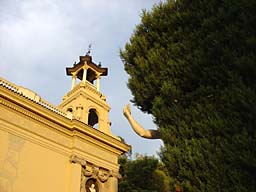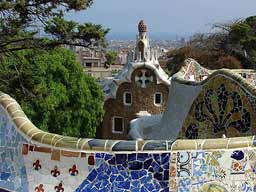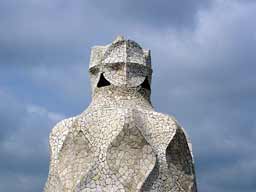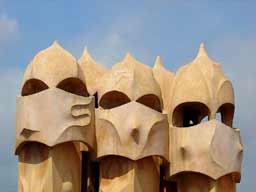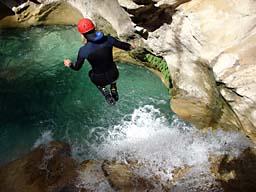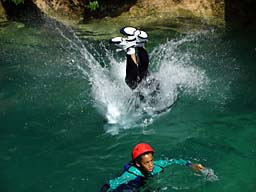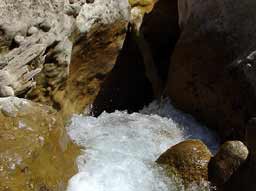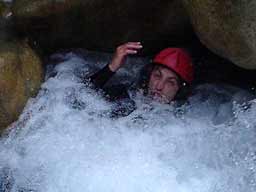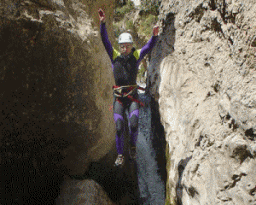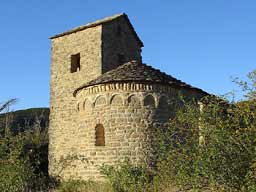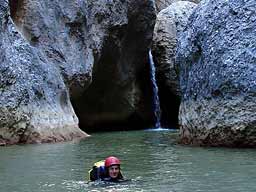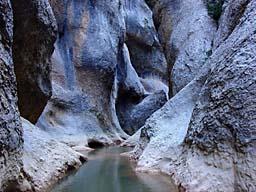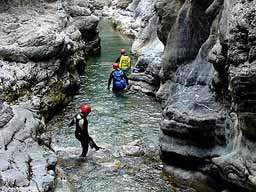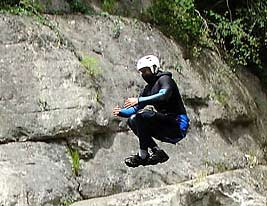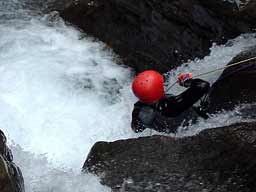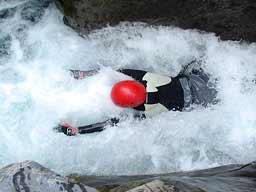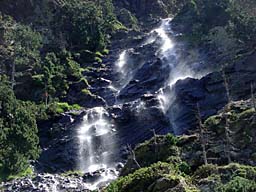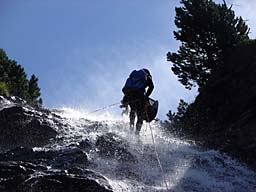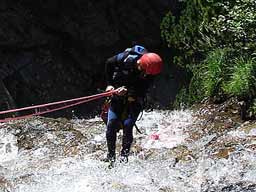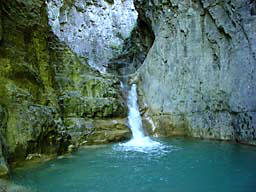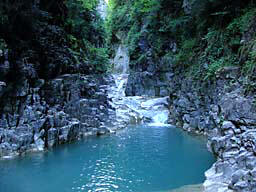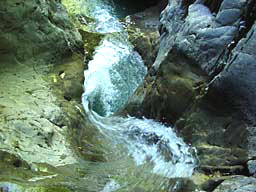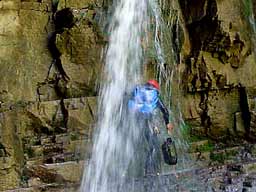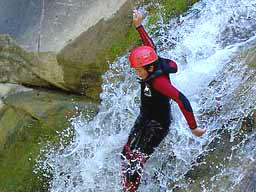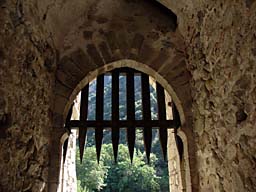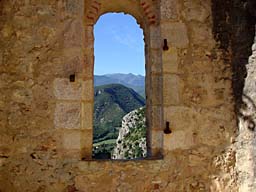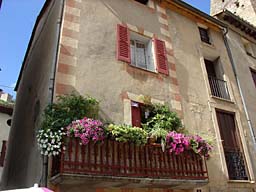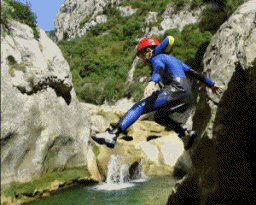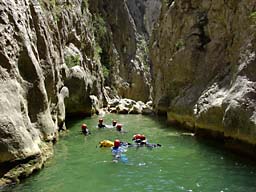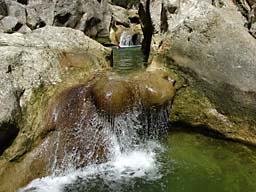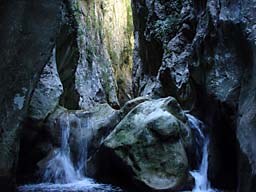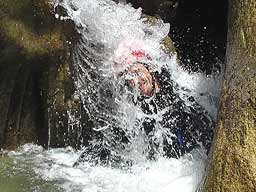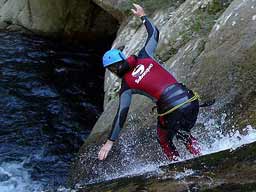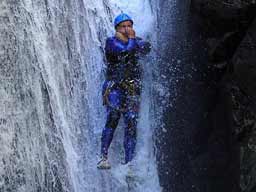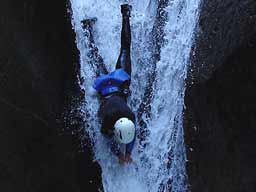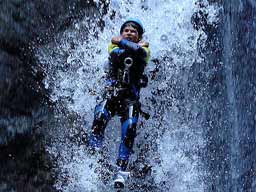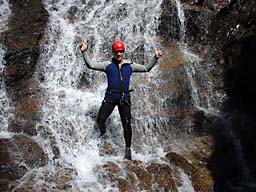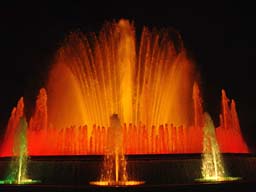Adventure TravelSPANISH COOLADEPart 3: CANYONEERING ONCE AGAIN IN THE SHADOW OF THE PYRENEES Nov. 20, 2004 (Click on any image for a larger version and a description)
The central square in Barcelona has many museums and a fantastic fountain (seen at the end of this report).IntroductionLooking out over Barcelona from Gaudi's Guelle Park.
The hand of the ancients beckoned. Come back to Barcelona and travel up into the mountains to experience the best that nature has to offer: spectacular scenery with steep gorges cut by the most magnificent crystal-clear emerald-green water one can imagine. When I visited the Pyrenees and the Sierra de Guara in May, the water levels were too high to safely descend a number of the area's most famous and beautiful canyons. So here it was, in mid August. I had two days in the capital of Catalonia, relaxing a little and trying to adjust to a nine hour time difference before heading out into the wilderness. Among the must-do things in Barcelona is a tour of the Modernista architecture of Antoni Gaudi. Guelle Park and several buildings in the city feature his stylized-colors and exotic-shapes, which established a unique congruence of art and engineering, of form and function. Along with visits to exhibits by Miro and Picasso, the two days went by pretty quickly, jet lag or not. I was here to descend canyons, especially the watery ones that now seemed quite ready for me (having more modest flow rates), and me for them. Below are brief descriptions, along with a few stories. Hopefully the photographs will inspire. I was shooting 3D, exclusively, with two digital cameras slaved together, and the "flatty" presentation given here fades a bit in comparison (i.e. if you ever get a chance to see my 3D show on this....). Nonetheless, one cannot help but be struck, in comparison with canyoneering on the Colorado Plateau, for example, that here the water is the dominant factor in the sport, and people respond in just about every way imaginable. At the start of each description I give, as was done in part1 and part 2, an aesthetic and beauty rating of 1 to 4 hearts ( ♥ ), and a technical difficulty rating of 1 to 6 (with 6 being "extremely difficult"). For most canyons, I got these ratings off the very useful guide maps produced by Patrick Gimat (who first descended a substantial number of the hundreds of canyons in this area). When not available off the two maps I have, I made up my own ratings, trying to keep the faith with those given by Gimat for canyons that I knew myself by actual experience. PEONERA INF ♥♥♥♥ / 4 A classic day-trip near Rodellar in the Sierra de Guara. Not a lot of big drops, but some route finding through regions of Caos (where the water tunnels under a maze of boulders), along with many jumps and waterfall down-climbs (or "in-water DC's"). A beautiful, though relatively easily accessed and hence popular, canyon.
The main difficulty in this canyon is the "Caos". Choose the wrong channel and get stuck, or worse, get sucked into a siphon. Some careful route-finding, along with fun tunneling, is required. In high water, the Caos sections can be quite dangerous. My companion in all this, Gabriel Hez, who I had met in Reunion Island, showed me where he had saved a young girls life in Peonera. She got sucked down a siphon, like that shown on the left just above, and the rest of her group didn't have a clue what to do (including the group's guide!). Gaby came along a few seconds after she was pulled down into the hole and managed to enter the Caos from below by swimming under a waterfall. We both swam into this infamous spot, shown below. Once he got inside the turbulent grotto, he tried to find the girl. Here he is (below), revisiting the location with me, and not looking too happy this time either. He couldn't see the girl in the incredible froth. Part of the problem was that she was wearing a white helmet, which is pretty invisible in the turbulence. He felt around for her in the roiling tumult with his feet. He managed to find her and pull her out, and saved her from certain drowning. Ever-after, red helmets are the norm!! GORGAS NEGRAS The classic of Sierra de Guara: ♥♥♥♥ / 4+ . This one has everything: jumps, down-climbs, tunnels, swims, string-of-pearls chained potholes, narrows, etc. Although it can be done without a rope (good DC'ing skills and a little fearless jumping required), I'm glad we took a cord with us, because a couple of the jumps had nasty looking logs in the plunge pools. It's a long trip, probably 25km or more, which is half approach and half canyon. The approach is pretty, but should be done at dawn before the terrain heats up. In the canyon, I stopped counting after about 100 potholes. Gaby estimated some 4+ km of swimming. The only downside for us was that some idiot had illegally let his herd of sheep out in the parkland above the canyon. They had waded and pooped in the water, so it wasn't as clear as normal. The flow was also a little too weak for my taste, especially at the top of the Gorgas before the springs added to the current. Bummer.
Into the play.MIRAVAL ♥♥♥♥ / 4 to 5+ . My personal goal was to descend all the four-heart ( ♥♥♥♥ ) canyons on the two Gimat maps I had (Monte Perdido and deGuara), as I'm in it primarily to sample briefly, before I get too old to limp into these places, the most beautiful spots I can find (technically difficult or not). Along with my trip in May, I would have mostly accomplished this wish, except for a little problem with one canyon (see below). Nonetheless, Miraval is another spectacular gorge, quite different from Gorgas Negras, with harder cleft-rock limestone walls instead of sedimentary domes and columns. Some great waterfall down-climbs and slides, and a few sporting jumps.
LA LARRI ♥♥♥♥ / 6 . This was first descended by Patrick Gimat et. al. in late September in 1997, at a time with minimum flow. When Gaby and I pulled into the parking lot way down below, with a couple 110meter ropes, a bolt-kit, and some other key ingredients, I looked up to see a set of monster waterfalls cascading down through clefts in a cliff-wall that started way up near the very top of the Pyrenees. Tomorrow is gunna be a grueling day, I thought, with a long climb up, and just the two of us to carry all the gear. The water was cold and very impressive! It looked like we would have to stay well out of most of the waterfalls to survive (advice local guide Koen Vienne had given me a few days earlier in a brief phone conversation). Then we saw four guys standing aside the road, surrounded by huge piles of rope (much more than we had). They didn't look too happy, in fact they were pretty pale. Barring a mis-translation, the gist of it was that some of the hardware, especially the bolts used to redirect around the big water, was a bit sketchy. One bolt had come out, and though, very fortunately, there was a second, the guy on-rope momentarily lost control, went into the fierce current, and almost drowned before extracting himself. All this put extra stress on the remaining pin, which the rest of the group then had to use (I guess they didn't have the gear to replace the bad bolt). Anyway, it was not a fun trip. I imagined Gaby and me up there, having to replace a lot of hardware while getting the crap pounded out of us. I thought this effort might well drain all my energy and put some of the canyons we had planned to do in the next few days in jeopardy. So I led a small crusade to bail this time around, and wait for some other day with less flow and maybe a couple more brave souls (like Koen) to join us and help repair the equipment.
SALCORZ ♥ / 5 Not to be denied a good waterfall canyon, though, we found a lesser but still impressive dude in a canyon named Salcorz. Same area, not quite as high, and with weak enough flow that you could rap right in the water (yes!). AND, for once in Spain, here was a canyon with NO BOLTS. Pristine rock or vegetable anchors. Well, there was one wiggly bolt. Not any more, 'cause Gaby pulled it. After the above story about bolts letting go in La Larri, you can understand why. BTW, Salcorz has about 19 wet raps, after a moderately difficult route-find to the top. But one heart for beauty? Pretty good difficulty rating, but only one heart for aesthetics? No way. I thought it was pretty cool. Maybe being a Colorado Plateau guy, rapp'n in water rates something for me, whereas for Patrick Gimat, well, maybe it's not so enthralling any more. Anyway, check out the pictures. See if a ♥♥♥ rating seems more appropriate.
BARBENUES ♥♥♥ / 3 ) About half way between La Larri and Ainsa we found a nice mellow canyon. Colorful and sublime, with a sporting waterslide at the end.
VILLAFRANCHE de CONFLUENCE Gaby live in this town, which is on the French side of the Pyrenees up in mountains north of Perpignan, which is itself down near the Mediterranean coast. The area is called the Pyrenees Orientale, because of its historic importance in the spice trade. It's an interesting countryside, laced with many medieval castles guarding small segments of land. Villafrance is a walled city that sits below an impregnable fortification. Apparently the only way to capture such a place was to surround it and starve the defenders out. Anyway, this is the gateway to some spectacular caving and canyoning opportunities on the east side the Pyrenees.
GALAMUS ♥♥♥ / 3 (my rating) Kind of a family canyon, but again very pretty with spectacular water. OK, not quite as nice as Peonera, or Fornocal and Oscurros de Balces (described Part 2), but better, water-wise, than anything I've yet found in Colorado. Way nice.
LLECH ♥♥♥♥ / 5 (my rating) Simply the best water-sports canyon I've ever done!! Jumps, slides, waterfall raps, waterfall downclimbs, etc. Perhaps not requiring the difficult technical rope-work nor having the huge drops of the canyons on Reunion Island, but still just plain great fun. There are a couple siphons (to be avoided of course). In higher water there is also a notoriously dangerous place where people have slid down an inviting-looking waterslide only to get both legs snapped off in a hidden rock trap. With legs bending backwards, like a bird's, as the water pushes the body forward while the lower legs remain caught, it's a dual tibia-breaker. Too many people have been helicoptered to hospital after going un-conscious upon seeing the terrible consequences of this notorious spot. Yikes!! Llech Canyon The joy of the water.
Not bad. Not bad at all, says I.
The Magic Fountain in Barcelona. A fitting end to my personal immersion in the best of nature's own flying water!!
|
© Hart3D - All Gallery images and videos are copyrighted John Hart. All rights reserved. No part of these pages, either text, videos, or images, may be used for any purpose other than for personal viewing. Reproduction, modification, storage in a retrieval system or retransmission, in any form or by any means, electronic, mechanical, or otherwise, is strictly prohibited without prior written permission.
|

